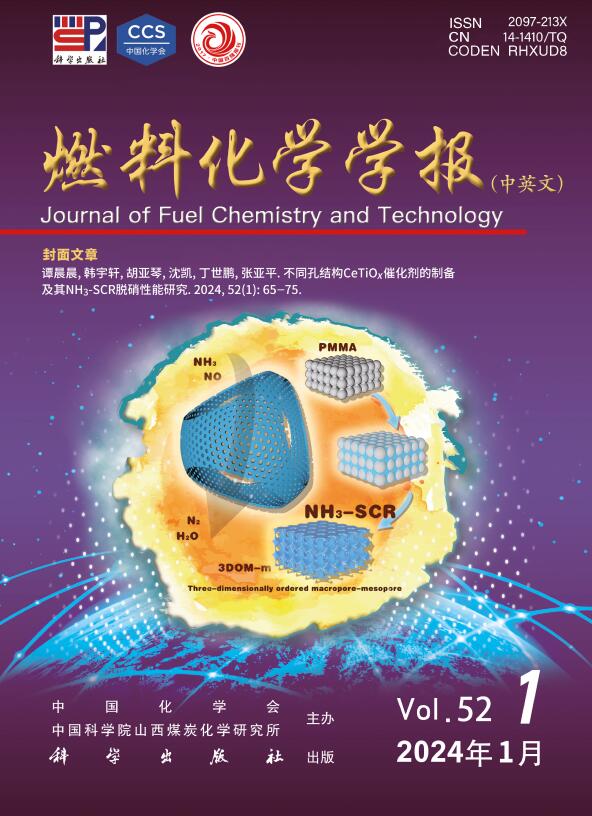多孔MgO/ zro2负载胺基吸附剂的制备及其在CO2捕集中的应用
Q3 Energy
引用次数: 0
摘要
目前,多孔结构固体吸附剂在CO2捕集中得到了广泛的应用。而未经改性的MgO-ZrO2吸附剂对CO2的吸附能力较低。本文通过在MgO/ZrO2孔载体上负载TEPA,成功合成了固体吸附材料。采用XRD、BET、FT-IR和SEM分析了样品的孔隙结构和表面特征。吸附材料呈现微晶状态,随着TEPA含量的增加,所有样品的结晶度逐渐降低。孔隙结构分析表明,经TEPA改性后的MgO-ZrO2吸附剂的比表面积减小,但其微介孔尺寸分布仍保持在1.8 ~ 12 nm范围内。FT-IR光谱结果进一步验证了TEPA的成功加载。用气相色谱吸附仪测试了吸附剂对CO2的吸附能力。结果表明,在75℃、常压条件下,当TEPA负载为50%时,样品对CO2的吸附值最大,达到4.07 mmol/g。这一结果不仅可以归因于碱活性位点的存在,还可以归因于吸附剂中微孔和介孔的共存。经过三次CO2捕集循环试验,样品对CO2的吸附值也可达到其原始吸附量的95%,验证了良好的循环运行稳定性。本文章由计算机程序翻译,如有差异,请以英文原文为准。
Preparation of porous MgO/ZrO2-supported amine-based adsorbents and their application in CO2 capture
Currently, the solid adsorbents with porous structure have been widely applied in CO2 capture. However, the unmodified MgO-ZrO2 adsorbents appeared to be low adsorption capacity of CO2. The solid adsorbent materials were successfully synthesized by loading TEPA onto the pore MgO/ZrO2 carriers in the paper. The pore structure and surface characteristic of the samples were analyzed by using XRD, BET, FT-IR and SEM. The adsorbent materials exhibited microcrystalline state, and the crystallinity of all samples gradually decreased as the increase of TEPA content. The pore structure analysis indicated that the modification of MgO-ZrO2 adsorbents with TEPA led to the decrease of the specific surface areas, but the narrow micro-mesopore size distributions ranging from 1.8−12 nm in the adsorbents still were maintained. FT-IR spectrum results further verified the successful loading of TEPA. The adsorption capacity of the adsorbents for CO2 were tested by using an adsorption apparatus equipped with gas chromatography. The results indicated that when the TEPA loading reached 50%, the sample exhibited the maximum adsorption value for CO2, reaching 4.07 mmol/g under the operation condition of 75 °C and atmospheric pressure. This result could be assigned to not only the base active sites but also the coexistence of both micropore and mesopore in the adsorbent. After three cycles tests for CO2 capture, the adsorption value of the sample for CO2 can also reached 95% of its original adsorption capacity, which verified the excellent cyclic operation stability.
求助全文
通过发布文献求助,成功后即可免费获取论文全文。
去求助
来源期刊

燃料化学学报
Chemical Engineering-Chemical Engineering (all)
CiteScore
2.80
自引率
0.00%
发文量
5825
期刊介绍:
Journal of Fuel Chemistry and Technology (Ranliao Huaxue Xuebao) is a Chinese Academy of Sciences(CAS) journal started in 1956, sponsored by the Chinese Chemical Society and the Institute of Coal Chemistry, Chinese Academy of Sciences(CAS). The journal is published bimonthly by Science Press in China and widely distributed in about 20 countries. Journal of Fuel Chemistry and Technology publishes reports of both basic and applied research in the chemistry and chemical engineering of many energy sources, including that involved in the nature, processing and utilization of coal, petroleum, oil shale, natural gas, biomass and synfuels, as well as related subjects of increasing interest such as C1 chemistry, pollutions control and new catalytic materials. Types of publications include original research articles, short communications, research notes and reviews. Both domestic and international contributors are welcome. Manuscripts written in Chinese or English will be accepted. Additional English titles, abstracts and key words should be included in Chinese manuscripts. All manuscripts are subject to critical review by the editorial committee, which is composed of about 10 foreign and 50 Chinese experts in fuel science. Journal of Fuel Chemistry and Technology has been a source of primary research work in fuel chemistry as a Chinese core scientific periodical.
 求助内容:
求助内容: 应助结果提醒方式:
应助结果提醒方式:


